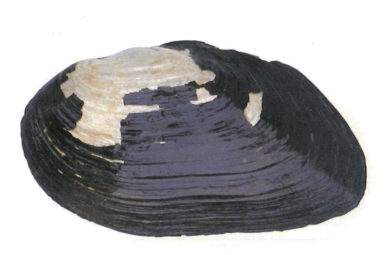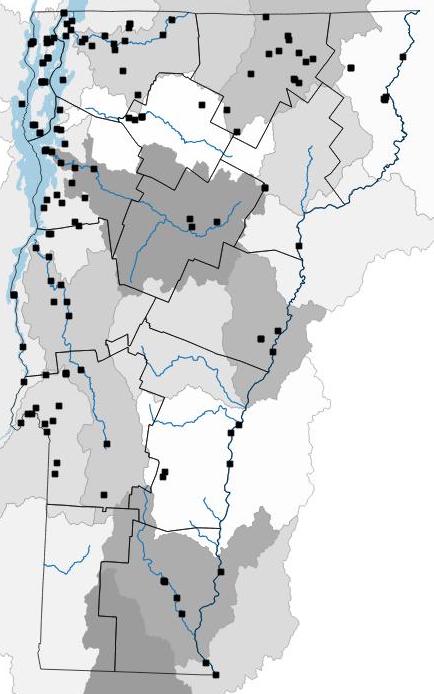 The Eastern Elliptio is the most common and widespread freshwater mussel in Vermont. Mussels beds can contain thousands of individual mussels. It often greatly outnumbers all other mussel species, and may comprise the largest proportion of animal biomass in many lakes and rivers, often far exceeding the combined biomass of other invertebrates and fish. It is a staple food item for muskrats and otters.
The Eastern Elliptio is the most common and widespread freshwater mussel in Vermont. Mussels beds can contain thousands of individual mussels. It often greatly outnumbers all other mussel species, and may comprise the largest proportion of animal biomass in many lakes and rivers, often far exceeding the combined biomass of other invertebrates and fish. It is a staple food item for muskrats and otters.
Key Characteristics
- Size: Up to five inches.
- Shape: Highly variable, but most often subtrapezoidal or subovate. Valves heavy, strong, and laterally compressed.
- Periostracum: Color tan (juveniles) to dark brown or black (adults). Shell rays may or may not be present.
- Lateral Teeth: Present. Two on the left valve and one on the right valve.
- Pseudocardinal Teeth: Present. Two on the left valve and one on the right valve.
- Nacre: Color usually white, rose-colored, or purple, and is often discolored.
- Similar Species: Eastern Pearlshell or Creeper. Rayed specimens may sometimes resemble Eastern Lampmussel.
Conservation Status
- State and Global Rank: S5 G5
Habitat
Found in lakes, rivers, and streams and in a wide variety of substrates – sand, silt, clay, gravel, cobble, and among large rocks. The most abundant mussel in lakes where it can be found in the thousands in some locations. Densest in rivers and streams along banks. Not likely to occur in high gradient streams where no other mussels occur.
Host Species
Uses a large number of host fish including yellow and white perch, large- and smallmouth bass, sunfish, and pickerel.
More Information
- Encyclopedia of Life
- NatureServe
- Musselp
- New Hampshire Species Page and Map
Range
The most widely distributed and common freshwater mussel in Vermont.
Distribution map has locations where this species has been documented and digitized into the atlas database. Systematic surveys have not been conducted for many species and those surveys that have been conducted have been largely focused on endangered species. Therefore, in some cases, the actual distribution of freshwater mussels may be more extensive than what is presented here. Shaded areas are watershed sub-basins and river main stems are shown.







